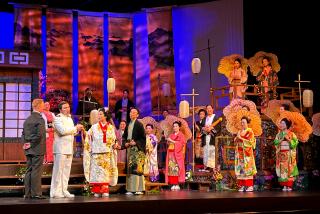STAGE REVIEW : NEW VIEW OF ‘PETRIFIED FOREST’
- Share via
Most of us know “The Petrified Forest” primarily as a film, with Humphrey Bogart as the killer on the lam and Bette Davis as the young waitress pining to get out of this Godforsaken hole and Leslie Howard as the ineffectual Englishman doing a far, far better thing than he has ever done.
But Robert E. Sherwood’s story was originally (1935) a play, one that rarely turns up in the theater these days. Perhaps it’s feared that it will look stage-bound next to the movie. Or maybe no one wants to compete with Bogie (he did the play as well) as Duke Mantee.
But it’s evident at the Los Angeles Theatre Center that a shrewd director and a strong acting company have nothing to fear from Sherwood’s script. Whether “The Petrified Forest” has anything to “say” to a contemporary audience--other than: Here’s what it was like in the mid-1930s--is doubtful. But it plays like gang-busters.
The director was Charles Marowitz, who likes to mug Shakespeare but seems perfectly content to assist a lesser writer like Sherwood in telling his tale more or less as he meant it. Marowitz’s staging doesn’t make us miss the camera. Oh, it might be nice to have an occasional long shot of the desert, and some intercutting might jazz up the final shoot-out, but in general the play seems quite at home in the enclosure of the theater.
It is, you’ll recall, about being in a box. Gabby, the young waitress (Judith Hansen), is drying up in the desert. Squier, the British writer (Rene Auberjonois), is imprisoned by his listless character. Even Duke Mantee (Philip Baker Hall)--who seems to have the drop on everybody--knows that the G-men are going to get him sooner or later.
What you may not recall is how Sherwood works out their stories. It won’t be revealed here, but it’s a much more interesting process than the viewer expects. For instance, you keep looking for Auberjonois as the writer to go after Hall’s gun. But the sacrifice he has in mind is more romantic, even though he has proclaimed romanticism dead, along with all the other isms of the day.
It’s characteristic of the production that Auberjonois stresses the writer’s vainglorious side, making him harder to take seriously than Howard in the movie. Marowitz doesn’t spoof the play, but he lets us see it with a certain relaxation, as an entertainment whose intellectual component may seem just a little quaint today.
The design contributes to that: That opening tableau in the roadside cafe has the glow of a Norman Rockwell cover. (D. Martyn Bookwalter did the set, Martin Aronstein the dusky lighting and Marianna Elliott the costumes.) And we’ve got to smile at the syrupy old tunes on the radio, too awful to have made it as standards. (Jon Gottlieb was sound designer.)
The environment is right, and the playing is splendid. It’s a big cast, with every face and accent right, and everybody’s story either stated or implied. The confidence starts with Armin Shimerman and David Stenstrom as two telegraph linemen having a political argument--an ongoing one, we’re sure--over coffee. Jim B. Baker as the cafe owner takes affront at its unpatriotic assumptions, and that’s both real and funny.
Judith Hansen makes his daughter bright, sensible and unmannered, a girl who could survive anywhere, but who needs someplace better than this. Hansen doesn’t make you forget Bette Davis. The question just doesn’t come up. You simply recognize the character.
It’s the same with Hall as Duke Mantee. He’s not playing Bogart. He’s not playing the qualities that we associate with desperadoes: brutality, fanaticism. He simply embodies these qualities, while putting his mind on such questions as “What’s my next move?” There’s also a careworn quality, pointing out the fact that the leader of a gang is an executive with constant personnel problems.
We notice as well how respectful Hall is of the waitress’s old and rather wild-eyed grandfather (John McLiam). It’s not a plot point, it’s not explained, but it strengthens our assent.
Christopher McDonald also does wonders with the role of an ex-college football hero (Nevada Tech) who could have come off simply as a goof. McDonald makes him solid and real, a baloney artist who happens to believe his own baloney--which is why he’s so successful with the girls.
That kind of playing allows this company to go into “The Petrified Forest” and come out with something fresh and original, at the same time doing full honors to the play Sherwood wrote. The play isn’t, I think, an American classic--only a semiclassic--but it’s in very good hands here.
‘THE PETRIFIED FOREST’ Robert E. Sherwood’s play, at the Los Angeles Theatre Center. Director Charles Marowitz. Producer Diane White. Set design D. Martyn Bookwalter. Lighting Martin Aronstein. Costumes Marianna Elliott. Sound Jon Gottlieb. Dramaturg Adam Leipzig. Production stage manager Charles McEwan. With Armin Shimerman, David Stenstrom, Jim B. Baker, Judith Hansen, John McLiam, Alma Beltran, Rene Auberjonois, Jack Axelrod, John C. Becher, Ronnie Clare Edwards, Leland P. Smith, Oz Tortora, Philip Baker Hall, Frank Collison, Earl Billings, Stanley Grover, Charles Parks, Bob Devin Jones. Plays Mondays-Saturdays at 8 p.m., with matinees at 2 p.m. Saturdays. Tickets $10-$20. 514 S. Spring St. (213) 627-6500.
More to Read
The biggest entertainment stories
Get our big stories about Hollywood, film, television, music, arts, culture and more right in your inbox as soon as they publish.
You may occasionally receive promotional content from the Los Angeles Times.










